The Athens combined ticket for the Acropolis and six more important ancient sites in Athens has been discontinued.
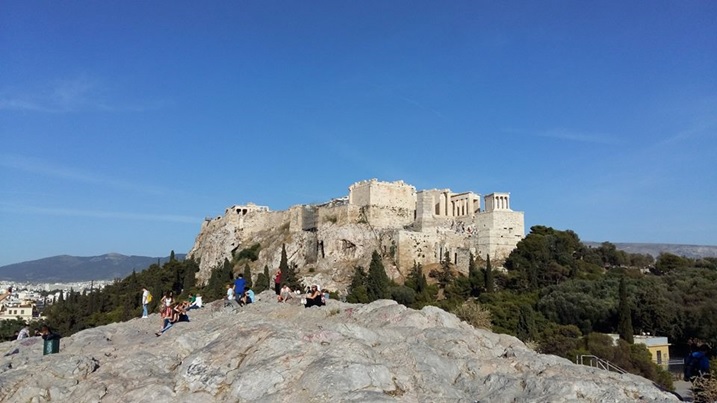
You can book a guided tour of the Acropolis (and, optionally the Acropolis Museum) on Get Your Guide or Viator.
If you only want to buy tickets for the Acropolis, you can book them on the official government website.
Here is a short description of the Acropolis and the other six ancient sites that you can visit in Athens.
The Acropolis and Ancient Athens combined ticket is no longer available
Ask anyone what is the number one thing to see in Athens, and they will definitely say “The Acropolis“. Without a doubt, the stunning 2,500 year-old archaeological site is a must-see when you are visiting Athens.
However, the Acropolis is not the only ancient site you can visit in the Greek capital! There are six more important ancient sites in Athens, including the Ancient Agora and the Temple of Zeus. Each of them offers a different perspective of life in Ancient Athens.
I’m Vanessa from Athens and have visited all the ancient sites more times than I can remember. There is something magical when it comes to seeing history with your own eyes!
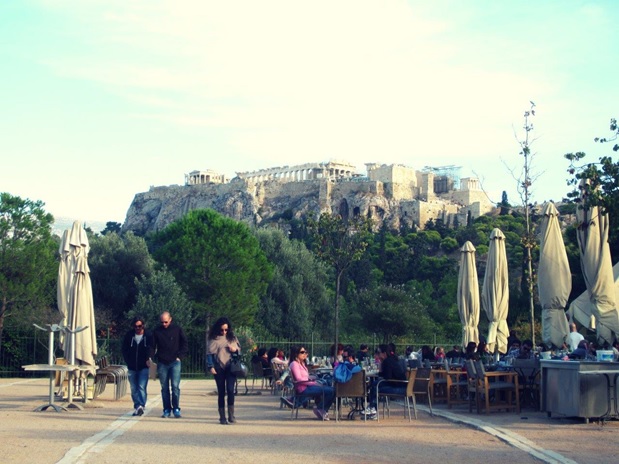
As of April 2025, you will need to buy individual tickets for each site you want to visit. Here is a short description of each of them:
The combined ticket for archaeological sites in Athens has been discontinued
There are seven ancient sites in central Athens that are open to visitors. As the Ancient Athens combined ticket is no longer available, you will need to purchase separate tickets for the sites you want to see.
Here are the seven ancient sites you can visit in central Athens:
- The Acropolis of Athens
- The Ancient Agora of Athens and the Museum of the Ancient Agora
- Kerameikos and the Archaeological Museum of Kerameikos
- The Temple of Olympian Zeus (Olympieio)
- The Roman Agora of Athens and the Tower of the Winds
- Hadrian’s Library
- Aristotle’s Lyceum (Archaeological site of Lykeion)
You can buy your Acropolis tickets on the official website. Note, however, that this doesn’t offer you the option to purchase any guided tours or audio guides.
Entrance to the ancient sites in Athens is free for EU citizens under 25 years old, and non-EU citizens under 18 years old. Senior discounts are also available. If you qualify for any of those, remember to bring your ID on the day you visit.
In addition, entrance to all the sites is free on selected dates during the year. Here is some more information: Free admission days for the ancient sites in Greece.
Guided tours in Athens
Taking a tour with a licensed guide will definitely enhance your experience and your visit to Athens. I’ve taken a number of Acropolis guided tours over the past couple of decades, and each time I learn something new!
There are dozens of tours to choose from, which you can compare and book on Get Your Guide or Viator.
For example, this guided tour of the Acropolis gets some of the highest ratings, and is excellent value for money.
Or you could go for this combined tour of the Acropolis and the Acropolis Museum instead. This one will give you a better insight on life in Ancient Athens.
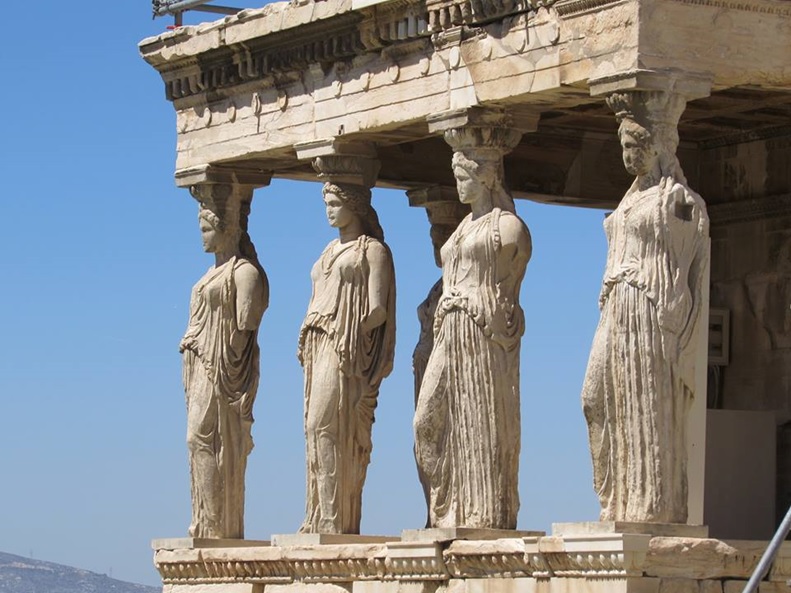
Of course, you can always visit the ancient sites on your own, without a guide. In this case, please make sure you read up before you visit. Apps with audio guides are also available.
And now, let’s look at the seven ancient sites that you can explore in Athens!
1. The Acropolis of Athens
The superb ancient Greek monumental complex known as the Acropolis of Athens was declared a UNESCO monument in 1987. It is located on a hill of about 150 m in central Athens, and consists of fortification walls and temples.
The first wall was built during the 13th century BC, in the Mycenaean era. The complex reached its peak in the 6th and 5th centuries BC, especially at the time when Pericles was ruling Athens.
Nowadays, you can see the remains of a number of monuments. The most famous temple is the Parthenon, which was dedicated to Athena, the city’s patron goddess.

Other important temples are the Erechtheion and the temple of Athena Nike, while the Propylaia Gate is monumental. You can also see the amazing Theater of Dionysus, and the Odeon of Herodes Atticus, also known as Herodion.
These ancient monuments have survived earthquakes, wars, bombings, alterations and even poor restoration works. They are still standing today, reminding everyone of Greece’s unique past!
Time required: 1.5-2 hours minimum
Single Entry Fee: 30 Euro
Closest Metro Stations: Acropolis and Thisseio
I recommend: Wear non-slippery shoes, and bring some water and a hat! Also, check out these tips for staying cool in the summer in Athens.
Acropolis Hours: 8:00-20:00 during summer, 8:00-17:00 during winter. In September and October, closing time varies, so check in advance of your visit.
You can read more about the Acropolis here: The Acropolis.
2. The Ancient Agora of Athens and the Museum of the Ancient Agora
In ancient Athens, the Agora was the heart of the city-state. In fact, the Greek word “agora” means “gathering place” or “assembly”.
The Agora was the centre of political, artistic, athletic, spiritual and everyday life of Athens. Along with the Acropolis, this is where Democracy, Philosophy, Theatre and Freedom of Expression and Speech were born.

The highlights of the Agora include the Stoa of Attalos, and the temple of Hephaestus. The Stoa of Attalos, which has been rebuilt and transformed into the Museum of the Ancient Agora, was quite possibly the first Mall in history.
The temple of Hephaestus is the best preserved temple in the whole of Greece!
Apart from those, you might be surprised to see a well-preserved Byzantine church, the Church of the Holy Apostles, built in the 10th century AD.
Time required: 2 hours minimum
Single Entry Fee: 20 Euro
Closest Metro Stations: Monastiraki and Thisseio
I recommend: Taking water with you (water might be available at vending machines inside, but it’s best to have some just in case).
Here is my article about the Ancient Agora in Athens. Also, here is a guide with a few useful words in Greek.
3. Kerameikos and the Archaeological Museum of Kerameikos
The archaeological site of the Kerameikos is often overlooked by visitors, but I strongly suggest you visit. It’s one of the most important areas of ancient Athens.
The area was developed around the banks of river Eridanos, whose banks are still visible today. Named after the Greek word for pottery, the area originally served as a settlement for potters and vase painters, and was the main production centre of the famous Athenian vases.
The site was later converted into a burial ground, which eventually became ancient Athens’ most important cemetery.

The site of Kerameikos contains a part of the Themistoclean Wall, which was built in 478 BC to protect the ancient city of Athens from the Spartans.
The Wall divided the Kerameikos into two sections, inner and outer Kerameikos. Inner Kerameikos (inside the city walls) developed into a residential neighbourhood, whereas outer Kerameikos remained a cemetery.
Parts of the Wall, together with the gate of Dipylon and the Sacred Gate are preserved today. These were the starting points of the Panathenaic procession and the procession of the Eleusinian Mysteries respectively.
Excavations in the Kerameikos area began in 1870. During the construction of Kerameikos metro station, approximately 1,000 tombs from the 4th and 5th centuries BC were discovered. Burial-related exhibits are showcased in the museum of Kerameikos.
Time required: 1.5 hours minimum
Single Entry Fee: 10 Euro (closed at time of writing)
Closest Metro Stations: Kerameikos and Thisseio
I recommend: Checking out the walls.
4. The Temple of Olympian Zeus (Olympieio)
The Temple of Olympian Zeus is one of the oldest temples in Athens, and one of the largest ever built in Greece. Its construction was initiated by the tyrant Peisistratus the Young in 515 BC, but was stopped due to the fall of tyranny.
It resumed in 174 BC by Antiochus IV Epiphanes, and was eventually completed by Emperor Hadrian in AD 124/125. Over the years, a new city wall, a large Late Roman cemetery, and an extensive Byzantine settlement were developed in the area.
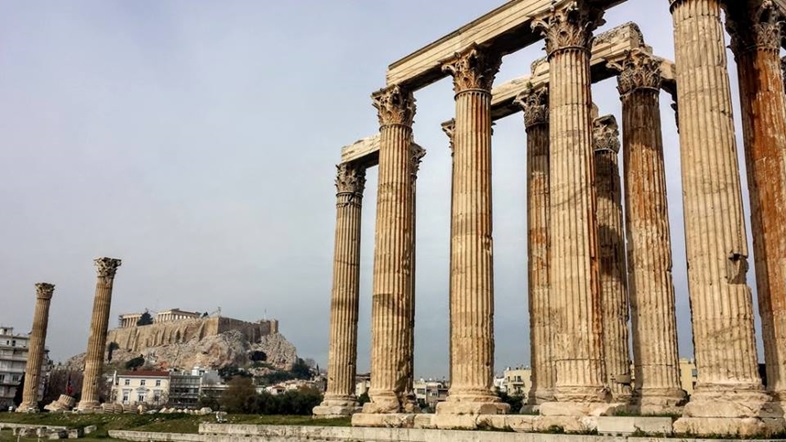
Excavations on the site began in 1883. Of the original 104 columns, only 15 remain standing today. A 16th column collapsed during an earthquake in 1852, and the pieces can still be seen on the ground.
The site is very impressive, not least for the sheer size of the columns! If you walk around, you can see Acropolis in the background.
Note: The temple is currently under restoration, and is covered with scaffolding. The photo above was taken a few years ago.
Time required: 1 hour minimum
Single Entry Fee: 20 Euro
Closest Metro Station: Acropolis
I recommend: Finding the perfect angle to take a photo of the temple, with the Acropolis in the background!
5. The Roman Agora of Athens and the Tower of the Winds
The Roman Agora of Athens was built between 19 – 11 BC, with donations by Julius Caesar and Augustus. After the Herulae invaded Athens in AD 267, it became the centre of the city of Athens.
During the Byzantine period and the Ottoman occupation, the site of the Roman Agora was covered by newly built houses, churches, the Fethiye mosque and workshops. Excavations of the site began in the 1830s.

Within the Roman Agora, you can also see the Tower of the Winds, built in the 1st century BC by the astronomer Andronicos, from Kyrrhos in Macedonia.
The tower is built of white Pentelic marble and is octagonal. It was originally used to identify the direction the wind blew; there were also sundials on the external walls and a water clock in the interior.
Over the years, it was converted into a Christian church and into the tekke of the Dervishes. Excavations started in 1837 and the latest restoration work finished in 2016.
Time required: Half hour minimum
Single Entry Fee: 10 Euro
Closest Metro Station: Monastiraki
I recommend: Looking at the stone carvings on the exterior of the Tower of the Winds.
6. Hadrian’s Library
The Roman emperor Hadrian built this library in A.D. 132, and at the time it contained several rolls of papyrus books. Like other ancient Greek monuments, it was destroyed by the Herulae in A.D. 267.
In subsequent years, different types of Christian churches were built on top of the site. During the Ottoman occupation, the site became the seat of the Governor (Voevode).
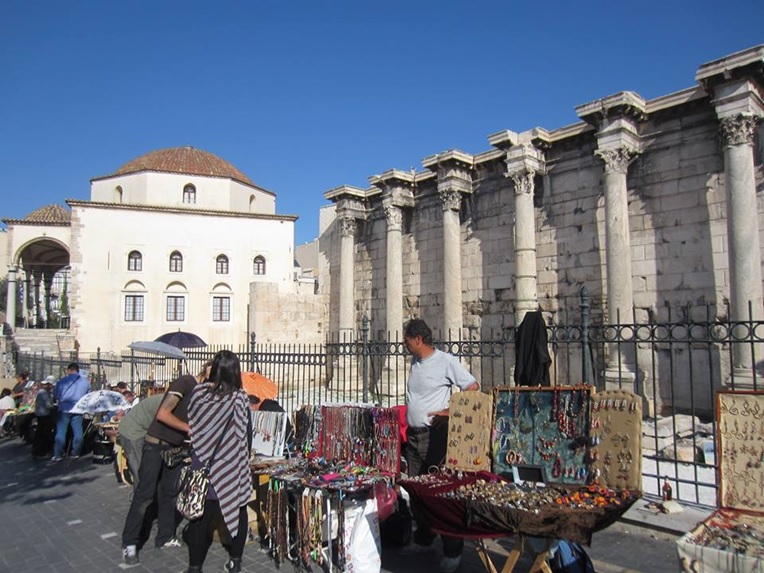
Time required: Half hour
Single Entry Fee: 10 Euro
Closest Metro Station: Monastiraki
I recommend: This is a quick site to look around when using Monastiraki station (it’s directly opposite).
7. Aristotle’s Lyceum (Archaeological site of Lykeion)
An archaeological site opened to the public in 2014, Aristotle’s Lyceum is a small park with a few ancient ruins. It’s definitely worth visiting if you have a special interest in ancient Greek philosophy.
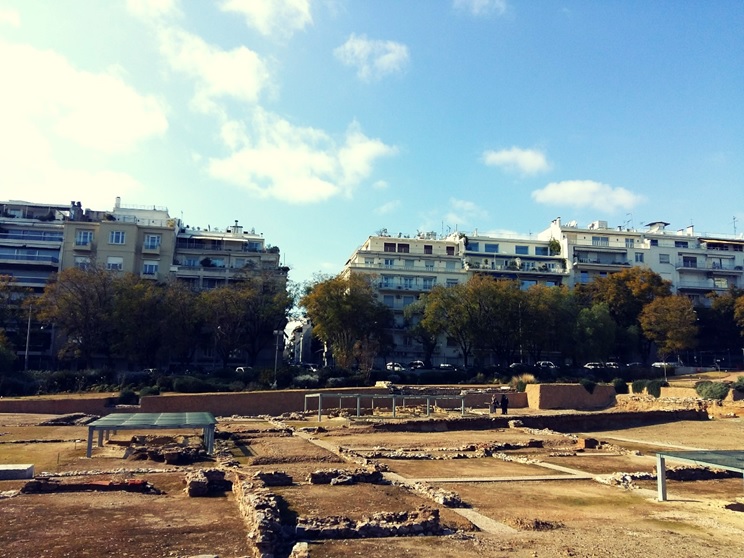
Aristotle’s Lyceum was one of the oldest gymnasia in ancient Athens. Aristotle founded his Walking School (Peripatetic School), based on the principles founded by Plato’s Academy, and taught from 335 – 323 BC.
This outdoors school taught rhetoric, philosophy and other disciplines. All Athenian men and youths were taught in the Lyceum, as part of their state military service.
These days, you can see the remains of several buildings, such as the gymnasia, a palestra, baths and a library.
You can easily combine this with a visit to the nearby historical museums. The Byzantine and Christian Museum, the Benaki Museum, and the Museum of Cycladic Art all offer a unique perspective on Greece’s long history.
Time required: Half hour
Single Entry Fee: 5 Euro
Closest Metro Stations: Evangelismos and Syntagma
I recommend: Reading about Aristotle and Ancient Greek philosophy before your visit!
FAQs about the combo ticket for the Acropolis
Here are a few questions that visitors ask:
Where can I buy Multi Site Tickets in Athens?
As of April 2025, the multi-site combo ticket in Athens is no longer available.
How much does it cost to visit the Acropolis of Athens?
Entrance to the Acropolis of Athens costs 30 euro. Various discounts apply.
Where can I buy Parthenon tickets?
You can buy tickets to visit the Parthenon at the official website.
Is the Acropolis free?
The Acropolis of Athens is free on 6 March, 18 April, 18 May, last weekend in September, 28 October, and the first and third Sunday in the off-season months (November – March). The Acropolis is also free for young people under 25 years old (EU) or 18 years old (non-EU).
What does Acropolis ticket include?
The Acropolis ticket includes entrance to the Acropolis Hill. You will see temples like the Parthenon, the temple of Athena Nike, and the Erechtheion with the famous Caryatids statues. This ticket does not include entrance to the Acropolis Museum.
When is the Acropolis closed?
The Acropolis of Athens remains closed on the following dates: 1 January, 25 March – Independence Day, Greek Easter, 1 May, 25 December – Christmas Day, and 26 December.
More travel guides for Athens and Greece
Visiting the Acropolis and the other ancient sites is only the beginning! Here are a few more articles which will help you discover ancient Athens and how to get around the city:
- Ancient Athens for free
- Panathenaic Stadium in Athens
- Athens walking tours with a local
- The temple of Poseidon at Cape Sounion
- How to take the Athens metro
- The OXI day, 28 October, in Greece
- Greek celebrations

Hi! I am Vanessa from Athens, and I love helping people discover more about Greece! I hope you have found this article on ancient Greek sites useful. Feel free to ask any questions right below! Follow me on my social media:
- Facebook page and very active Facebook group
- Amazon
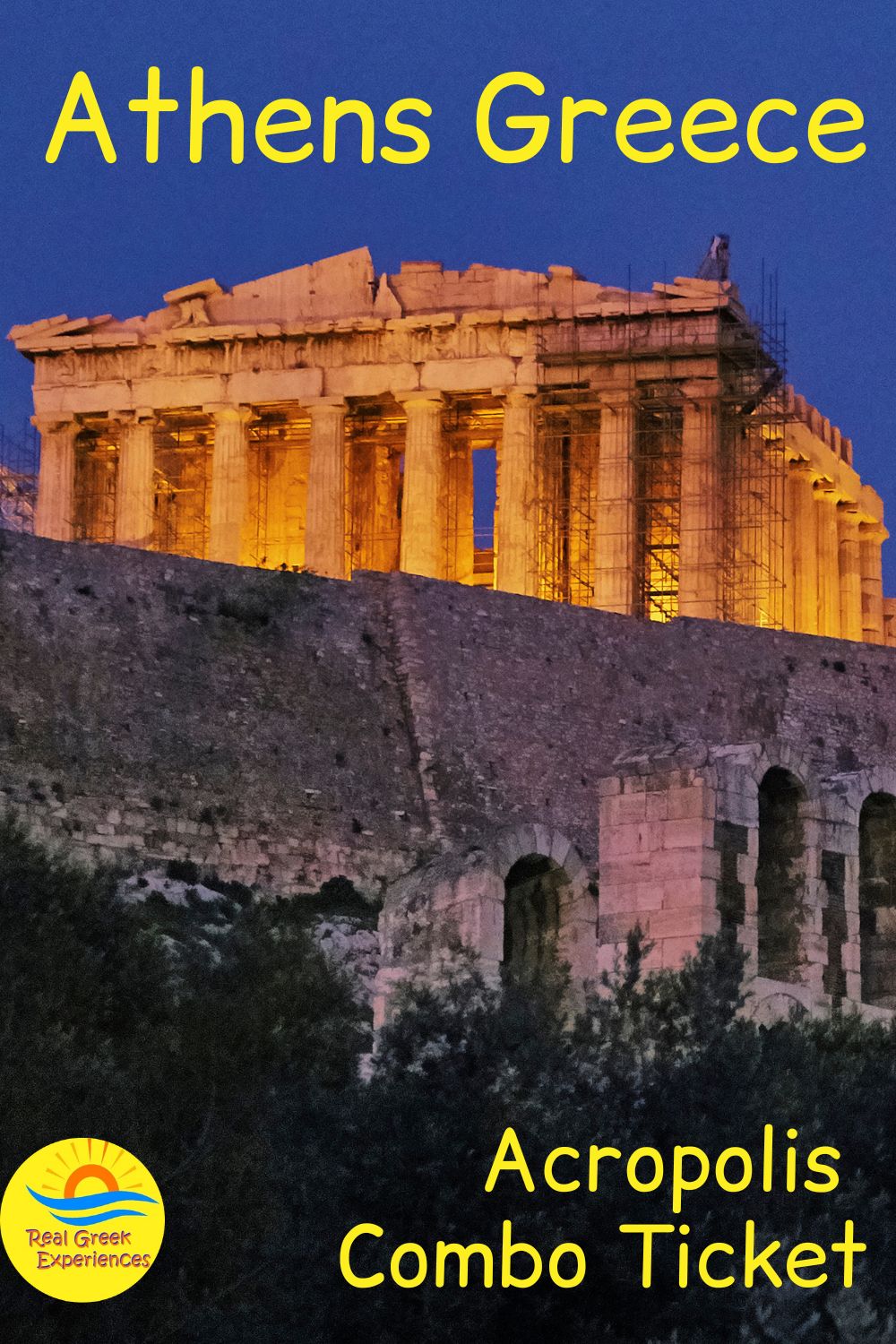

Hello
Does this combined ticket to archaeological sites of Athens enable you to jump the queue? I have seen the ‘no line’ tickets advertised elsewhere?
jane
I’m interested in getting the combined ticket to archaeological sites. Your site says your can’t buy these online, so where do I get them?
Hi Karen! In fact, as is stated in the article, it is indeed possible to get the combined ticket online. “Note that it is possible to get full-price tickets online, a few months in advance of your visit.” This is the website you need to use https://etickets.tap.gr/. You will need to choose “Attica”, select any of the sites, and then proceed to a next screen where it gives you the option for the 30 euro combined ticket. However, if you are entitled to a discount, the system doesn’t support this yet.
Hope this helps!
Cheers from a sunny Athens,
Vanessa
Is there any way to change to English? I can book otherwise
Just check the top right hand corner, there’s a small “EN” sign.
With the combined ticket, are you able to visit the same site multiple times? For example, can we go to the Acropolis during the day on Monday and then go back to the Acropolis at night on Tuesday?
Hello, no you can’t! Thanks for asking, I will include this in the article. Please also note that the Acropolis Museum is not included! Enjoy your time!
Hello,
If I buy the combined ticket, is it valid only for 1 day, or I can use it on other days?
Hi! The ticket is valid for 5 days. Enjoy your visit!
I clicked on attica but the page doesn’t show the continue button. I see ‘continuity’ and the drop down options beside it on the left shows places in greek language. the page virtually is frozen
Right, well who knows why! You can either try again on another day, or get them through this link
Hello!
We’re going to Athens March 30 to April 2 only and are looking to book a Athens Combo Ticket for 6 sites.
It says on the site that the ticket is only valid until March 31st and there is no possibility yet to book tickets from April 1st.
Question: If we book and pay tickets with first use on March 31st, will the ticket still be valid for visits on April 1st and April 2nd? (Since I see it’s 5 days in total from first entrance registered)
Thank You for Your kind reply.
Lars
Yes your combo ticket will be valid for 5 days! I think they will only release April tickets on March 31st, which is why you can’t book it now. Enjoy your stay!
Thank you for this informative post. I’ve looked for this information everywhere, but couldn’t find it – maybe you could help me? I know EU citizen kids have free entry and you have to get them a ticket at the front ticket office. Do I have to do that every time we go to one of the sites, or do they get a free combo ticket once we go to the first site and buy my adult ticket?
Thanks for your question! You can ask for a free combo ticket for the children at the first site you go, so you won’t have to queue at the others (i.e. the Acropolis). Enjoy your time!
Thank you for the great information. I read on one of your posts that European Heritage is celebrated the last weekend in September this year. As I will be in Athens that weekend, do I need to purchase the Athens Combo ticket? Thank you,
Kathy
Hi Kathy! The ancient sites will be free on that weekend so you won’t need to buy the ticket. You will still need to buy one for the Acropolis Museum though. Enjoy your time!
Thanks for the information. A few questions about the combo ticket: For the original purchase you have to choose a day and time. Am I obligated to go to that sight at that specific time? Do I have to go to that sight before going to any of the other sights? And finally, can I go to more than one sight on the same day? Thank you.
Hi! You can go to each site at any time you want, and you can go to more than one sites on the same day! Enjoy!
Hi! Thank you for this useful guide!
I’ll be in Athens from 17th of September and planning to visit the Acropolis on the 19th. But I want to visit the other sites on the 17th and 18th. I am wondering which date and time I need to select for my ticket.
The official website, even when booking for the combo ticket, asks to chose a date and time to visit the Acropolis. My question is: what date and time should I select for my ticket if I want to visit the Acropolis on 19th at 8am but all the other sites from the 17th?
if I select the 19th at 8am, does it mean that the ticket will be valid from the 19th? and what if I select the 17th, will I be able to visit the acropolis on the 19th instead?
It’s a bit confusing, hopefully you can help me:)
Thanks! Chiara
Hi Chiara, as this system is very new, I am afraid I am not sure myself. Since you are planning to visit one of the other sites first, you can actually get your combo ticket in person at the entrance, it’s only the Acropolis that has queues. By the way, it’s actually best to visit the Acropolis later on in the day rather than 8 am, as this is when cruise passengers visit and it tends to be a lot busier. Enjoy your time!